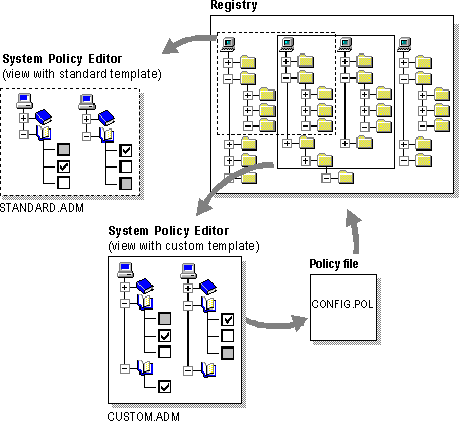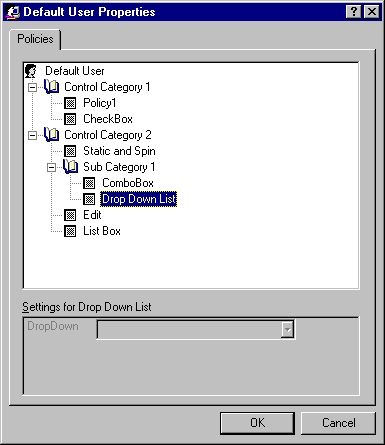
When you run System Policy Editor, Windows 95 opens the default policy template, which contains existing policies that you can enable or modify. A template is a listing of the possible policies that you can use. By default, this template file is named ADMIN.ADM and is stored in the Windows INF directory.
This section describes how you can create custom system policy templates (.ADM files) and switch between multiple templates in System Policy Editor.
For example, it might be helpful to have system policy settings for corporate-specific applications, such as an in-house database, custom front end, or electronic mail package. After a template has been customized, you can then load the template and use it to set values in the Registry.
Note
If you want to define system policies for applications, the applications must be able to read the Windows 95 Registry.
Creating your own template is helpful when you want to define a specific set of Registry settings in your system policies, including settings not definable by default through System Policy Editor. As shown in the following illustration, the template defines the policies you can set through System Policy Editor. Changes you make there are reflected in the policy file (shown in the example as CONFIG.POL), which in turn updates the Registry when the user logs on.

You can create your own templates that can be read by System Policy Editor. Users can then load the template and use it to set values in the Registry. To create a template, use a text editor such as WordPad to edit or write an .ADM file. You can open the default template named ADMIN.ADM in the Windows INF directory to use as an example.
A template uses several key words, syntaxes, and symbols, as summarized in the following list.
The following table describes the keywords in system policy templates. Following this table are lists of the controls and values that can be defined in templates.
System Policy Template Key Words
Template key word | Description |
CLASS | Defines the Registry key that can be edited; the value must be USER or MACHINE, corresponding to Hkey_Current_User or Hkey_Local_Machine, respectively. |
CATEGORY name | Defines a category in System Policy Editor. If a name contains spaces, it must be enclosed in quotes. A category statement can appear only once for each category name. |
END CATEGORY | Defines the end of a category and all of its policies. |
POLICY name | Defines a policy within a category. Policy names that contain spaces must be enclosed in quotes. |
END POLICY | Defines the end of a policy and all its parts. |
PART name | Defines one or more controls that can be used to set the values of a policy. Part names that contain spaces must be enclosed in quotes. Policy part types and type-dependent data are described in the following tables. |
END PART | Defines the end of the control list. |
VALUEON | Specifies the setting to assign to the value when the policy is checked. |
VALUEOFF | Specifies the setting to assign to the value when it is not checked. |
KEYNAME | Specifies the full path of the Registry key. This is an optional Registry key name to use for the category or policy. If there is a key name specified, it is used by all child categories, policies, and parts, unless they define a key name of their own. |
VALUENAME | Defines the Registry value entry name. |
VALUE | Specifies the Registry value to set to a VALUENAME. |
!! | Indicates a string value. |
[strings] | Defines a section containing string values. |
A system policy template uses the following part control indicators.
System Policy Template Part Control Indicators
Part Control Indicator | Description |
CHECKBOX | Displays a check box. The value is nonzero if checked by the user, and its value entry is deleted if it is unchecked. |
NUMERIC | Displays an edit field with an optional spin control that accepts a numeric value. |
EDITTEXT | Displays an edit field that accepts alphanumeric text. |
COMBOBOX | Displays a combo box, which is an edit field plus a drop-down list for suggested values. |
TEXT | Displays a line of static (label) text. There is no Registry value associated with this part type. |
DROPDOWNLIST | Displays a drop-down list. The user can choose from only one of the entries supplied. The main advantage of a drop-down list is that, based on the user's selection, a number of extra Registry edits can be performed. |
LISTBOX | Displays a list box with Add and Remove buttons. This is the only part type that can be used to manage multiple values under one key. |
A system policy template uses the following type-specific information.
System Policy Template Type-Specific Information
Type-specific modifier | Description |
CHECKBOX: | |
DEFCHECKED | Causes the check box initially to be checked. |
VALUEON | If specified, overrides the default "on" behavior of the check box. For example: VALUEON "On" writes "On" to the Registry. |
VALUEOFF | If specified, overrides the default "off" behavior of the check box. For example: VALUEOFF "Off" writes "Off" to the Registry. |
ACTIONLISTON | Specifies optional action list to be taken if check box is "on." |
ACTIONLISTOFF | Specifies optional action list to be taken if check box is "off." |
NUMERIC: | |
DEFAULT value | Specifies initial numeric value for the edit field. If this statement is not specified, the edit field is initially empty. |
MIN value | Specifies minimum value for number. Default value is 0. |
MAX value | Specifies maximum value for number. Default value is 9999. |
SPIN value | Specifies increments to use for a spin control. Specifying SPIN 0 removes the spin control; SPIN 1 is the default. |
REQUIRED | If specified, System Policy Editor will not allow a policy containing this part to be enabled unless a value has been entered. |
TXTCONVERT | Writes values as strings rather than binary values. |
EDITTEXT: | |
DEFAULT value | Specifies the initial string to place in the edit field. If this is not specified, the field is empty initially. |
MAXLEN value | Specifies the maximum length of the string in the edit field. |
REQUIRED | If specified, System Policy Editor will not allow a policy containing this part to be enabled unless a value has been entered. |
COMBOBOX: | |
Accepts all the key words that EDITTEXT does, plus SUGGESTIONS. | |
SUGGESTIONS | Begins a list of suggestions to be placed in the drop-down list. Suggestions are separated with spaces and can be enclosed by quotes. The list is terminated with END SUGGESTIONS. For example: SUGGESTIONS |
TEXT: | Contains no type-specific data. |
DROPDOWNLIST: | |
REQUIRED | If specified, System Policy Editor will not allow a policy containing this part to be enabled unless a value has been entered. |
ITEMLIST | Begins a list of the items in the drop-down list. The end of the list must be terminated by END ITEMLIST. Each item in the list is specified as follows: NAME name VALUE value name is the text to be displayed in the related drop-down list. value is the value to be written for the part's value if this item is selected. Values are assumed to be strings, unless they are preceded by the key word NUMERIC. For example: VALUE "Some value" If the VALUE key word is followed by the DELETE key word (that is, VALUE DELETE), then this Registry name/value pair will be deleted. actionlist is an optional list to be used if this value is selected. |
LISTBOX: | |
VALUENAME | Cannot be used with the list box type, because there is no single value name associated with this type. By default, only one column appears in the list box, and for each entry a value is created with an identical value name and value data. For instance, the List Entry value in the list box would create a value named "List Entry" containing "List Entry" as data. |
VALUEPREFIX prefix | Defines the prefix to be used in determining value names. If a prefix is specified, then this prefix plus "1," "2," and so on will be used instead of the default value naming scheme listed earlier in this table. The prefix can be empty (" "), which will cause the value names to be "1," "2," and so on. A prefix of SomeName will generate value names "SomeName1," "SomeName2," and so on. |
EXPLICITVALUE | Causes the user to specify the value data and the value name. The list box shows two columns for each item, one for the name and one for the data. This key word cannot be used with the VALUEPREFIX key word. |
ADDITIVE | If specified, values set in the list box are added to whatever values exist in the target Registry. Existing values are not deleted; by default, the content of list boxes will "override" whatever values are set in the target Registry. Specifically, a control value is inserted in the policy file which causes existing values to be deleted before the values set in the policy file are merged. |
Strings: | |
!! | Indicates a string value. For example: !!StrConst |
[strings] | Defines a section of string values; the values are defined in the following format: var_name=string value For example: StrConst="Control Name" |
Comments | Can be added by preceding the line with a semicolon (;). |
\\\new
The following example shows a template that uses all the types of controls. This sample .ADM file is included with the Windows 95 Resource Kit utilities.
CLASS USER
CATEGORY "Control Category 1"
KEYNAME KeyName1
POLICY "Policy1"
; actions to take when policy is checked
ACTIONLISTON
KEYNAME KeyName1
VALUENAME Checked1 VALUE "AAA"
VALUENAME Checked2 VALUE "BBB"
VALUENAME Checked3 VALUE "CCC"
KEYNAME KeyName2
VALUENAME Unchecked1 VALUE DELETE
VALUENAME Unchecked2 VALUE DELETE
VALUENAME Unchecked3 VALUE "not checked"
END ACTIONLISTON
; actions to take when policy is unchecked
ACTIONLISTOFF
KEYNAME KeyName1
VALUENAME Checked1 VALUE ""
VALUENAME Checked2 VALUE ""
VALUENAME Checked3 VALUE ""
KEYNAME KeyName2
VALUENAME Unchecked1 VALUE "AAA"
VALUENAME Unchecked2 VALUE "BBB"
VALUENAME Unchecked3 VALUE "CCC"
END ACTIONLISTOFF
END POLICY
POLICY "CheckBox"
PART "CheckBox1:" CHECKBOX DEFCHECKED
VALUENAME "CheckBox Control"
VALUEON "is checked" VALUEOFF "is not checked"
END PART
END POLICY
END CATEGORY
CATEGORY "Control Category 2"
KEYNAME KeyName3
POLICY "Static and Spin"
PART "Below is a spin control" TEXT
END PART
PART "Spin:" NUMERIC SPIN 10 REQUIRED
MAX 110
VALUENAME "Spin"
END PART
END POLICY
CATEGORY "Sub Category 1"
KEYNAME KeyName4
POLICY "ComboBox"
PART "Combo:" COMBOBOX
SUGGESTIONS
One Two Three Four
END SUGGESTIONS
VALUENAME "Combo Control"
END PART
END POLICY
POLICY "Drop Down List"
PART "DropDown" DROPDOWNLIST
VALUENAME DropDown REQUIRED
ITEMLIST
NAME "Name One" VALUE "Value One"
ACTIONLIST
VALUENAME "Value Name 1" VALUE "Value 1"
VALUENAME "Value Name 2" VALUE "Value 2"
END ACTIONLIST
NAME "Name Two" VALUE "Value Two"
ACTIONLIST
VALUENAME "Value Name 1" VALUE DELETE
VALUENAME "Value Name 2" VALUE DELETE
END ACTIONLIST
NAME "Name Three" VALUE NUMERIC 333
NAME "Name Four" VALUE "Value Four"
END ITEMLIST
END Part
END POLICY
END CATEGORY
POLICY "Edit"
PART "Edit" EDITTEXT
MAXLEN 10
VALUENAME Edit
DEFAULT "Edit Default"
END Part
END POLICY
POLICY "List Box"
KEYNAME KeyName5
PART "List Box Control" LISTBOX EXPLICITVALUE
END PART
END POLICY
END CATEGORYThe following shows the policies created by this sample .ADM file as they appear in System Policy Editor.
